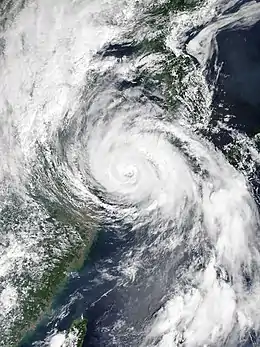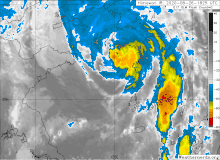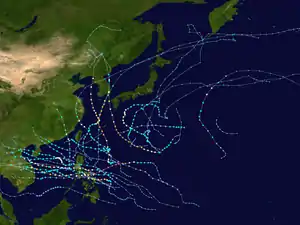Typhoon Bavi (2020)
Typhoon Bavi, known in the Philippines as Severe Tropical Storm Igme, was a powerful tropical cyclone that made landfall in North Korea in August 2020. The eighth named storm and third typhoon of the 2020 Pacific typhoon season, Bavi formed from a low pressure area depression on August 21 to the north of the Philippines and strengthened into a tropical storm on August 22. Bavi gradually strengthened as it skirted Taiwan and Okinawa, and became a typhoon on August 24. Passing over warm waters, Bavi turned to northwest and reached its peak intensity near Jeju Island on August 26. Thereafter, increasing wind shear and cooler waters caused Bavi to quickly weaken. Bavi made landfall in North Korea on August 27, and became an extratropical cyclone shortly thereafter.
| Typhoon (JMA scale) | |
|---|---|
| Category 3 typhoon (SSHWS) | |
 Bavi at peak intensity near Jeju Island on August 26 | |
| Formed | August 20, 2020 |
| Dissipated | August 30, 2020 |
| (Extratropical after August 27) | |
| Highest winds | 10-minute sustained: 155 km/h (100 mph) 1-minute sustained: 185 km/h (115 mph) |
| Lowest pressure | 950 hPa (mbar); 28.05 inHg |
| Fatalities | 1 total |
| Damage | $11.7 million (2020 USD) |
| Areas affected | Philippines, Ryukyu Islands, Taiwan, Korean Peninsula, North China, Northeast China |
| Part of the 2020 Pacific typhoon season | |
Bavi caused minimal damage in portions of South Korea and Japan, but caused widespread structural damage and flooding in North Korea. It was the first storm in two weeks span to affect Korea. Others were Maysak and Haishen.
Meteorological history

On August 19, the JTWC began monitoring a broad area of low pressure situated a couple hundred miles northeast of the Philippine archipelago. By the next day, the system rapidly organised, and the JTWC subsequently issued a Tropical Cyclone Formation Alert (TCFA). On August 21, the area of low pressure became Tropical Depression 09W.[1] At 15:00 UTC, the PAGASA named the system "Igme" and issued a severe weather bulletin for it.[2] By the next day, Igme intensified into a tropical storm, according to the JMA and was given the name Bavi, subsequently prompting the JTWC to follow suit and upgrade 09W from a tropical depression to a tropical storm.[3] Favorable conditions allowed Bavi to rapidly intensify, and by 12:00 UTC on August 22, the system became a severe tropical storm. As the system left the Philippine Area of Responsibility, the PAGASA stopped issuing weather bulletins for the severe tropical storm.[4] Bavi's period of rapid intensification was brief, and it began a slow intensification phase on August 23.
On August 24, Bavi slowly intensified, and it was later upgraded by the JMA into a typhoon. Later on that day, it became a Category 2 typhoon. By the next day, Bavi intensified even more to become a major Category 3 typhoon. As Bavi moved closer to the Korean peninsula, one person died in Jeju island on August 25.[5] Soon afterwards, as Bavi moved northwards it found very hostile conditions and high wind shear, that subsequently caused rapid weakening of the storm. Shear levels were high and the storm started an extratropical transition. Around 00:30 UTC on August 27, a weakened Bavi made landfall over North Pyongan Province, North Korea, as a minimal typhoon.[6] Hours later both JMA and JTWC issued their final advisory on Bavi, as it became an extratropical cyclone over Northeastern China.
Preparations, impact, and aftermath
Japan
Bavi caused wind gusts of over 60 mph (96 km/h) and dropped 300 mm (12 inches) of rain on the island of Okinawa.[7] Agricultural damage in Okinawa Prefecture was JP¥25.14 million (US$237 thousand).[8] Large waves associated with Bavi were reported as far away as Kagoshima Prefecture.[9]
South Korea
In South Korea, as a precaution over 470 flights were cancelled and railroad services were halted. Public parks were also closed for the typhoon.[10]
In Jeju Island, five people were swept away by strong waves, one of them died later.[11] Heavy rainfall was also reported in the island with a maximum amount of 399.5 mm (15.73 in) being reported near Mount Halla.[12] Despite a close pass to mainland South Korea, damage was minimal, consisting mostly of power outages, broken windows, and downed trees. Nevertheless, more than 100 reports of damage was submitted. The typhoon forced about 30 people in Gokseong, South Jeolla Province, to evacuate due to landslides. About 440 flights were cancelled at eleven airports across the country, while nearly 160 passenger ferries were grounded on 99 ferry routes.[13] Roughly 1,600 households in South Korea lost power.[14] Losses in Jeju reached ₩484 million (US$408 thousand).[15]
North Korea

North Korean leader, Kim Jong Un, held a high-level political conference where he voiced his concerns about Typhoon Bavi and the COVID-19 pandemic.[16]
In North Korea, snapped utility poles and trees were reported near Bavi's landfall location, as well as flooded roads. A peak precipitation amount of 224 mm (8.81 in) was reported in Anju.[7] Several homes and public buildings were damaged in North and South Hwanghae provinces.[17]
In an unusual step, North Korea's state television network broadcast overnight as the typhoon impacted the country, interrupting programs every 30 minutes with updates on the storm's progress from the State Hydro-Meteorological Administration. It later broadcast images of storm damage, as well as field reports from correspondents in Pyongyang and Nampo.[18][19]
China
Several weather alerts were issued for portions of China as Typhoon Bavi neared. The Chinese Ministry of Emergency Management stated that 20,000 firefighters had been deployed equipped with 329 rescue boats.
In Northeast China, rounds of heavy downpours brought up to 150 mm (5.9 in) of rainfall in some areas.[20] Damage in Dalian amounted to be CN¥76.54 million (US$11.1 million).[21]
See also
- Tropical cyclones in 2020
- Typhoon Kompasu (2010) – Affected the South Korean capital, Seoul.
- Typhoon Bolaven (2012) – Another typhoon that made landfall as a tropical storm in North Korea.
- Typhoon Maysak (2020) – a storm that struck South Korea a week later
- Typhoon Haishen (2020) – a storm that struck the Korean Peninsula after Bavi and Maysak
References
- Joint Typhoon Warning Center (August 21, 2020). "Tropical Cyclone Formation Alert WTPN21". Joint Typhoon Warning Center (JTWC). Archived from the original on August 21, 2020. Retrieved August 21, 2020.
- Philippine Atmospheric, Geophysical and Astronomical Services Administration (August 22, 2020). "Severe Weather Bulletin #1". PAGASA. Archived from the original on August 22, 2020. Retrieved August 22, 2020.CS1 maint: unfit URL (link)
- "Japan Meteorological Agency | Tropical Cyclone Information". Archived from the original on August 22, 2020. Retrieved September 9, 2020.
- Philippine Atmospheric, Geophysical and Astronomical Services Administration (August 22, 2020). "SEVERE WEATHER BULLETIN #4-FINAL" (PDF). PAGASA. Archived from the original on August 23, 2020. Retrieved August 23, 2020.CS1 maint: unfit URL (link)
- "태풍 바비 잇단 피해..물놀이 10대 사망-하늘·바닷길 끊겨[태풍 바비 경로]". www.sisa-news.com (in Korean). Retrieved August 26, 2020.
- Wang Qian (August 27, 2020). "中央气象台8月27日8时30分发布台风登陆信息" (in Chinese). Beijing, China: National Meteorological Center of CMA. Archived from the original on August 27, 2020. Retrieved August 27, 2020.
- https://www.accuweather.com/en/hurricane/bavi-lashes-korean-peninsula-moves-into-china/799752
- 台風8号の農林漁業被害2514万円 9割がサトウキビ (in Japanese). Ryukyu Shimpo. August 27, 2020. Retrieved September 9, 2020.
- "Typhoon Bavi batters Japan with strong waves". news.yahoo.com. Retrieved September 9, 2020.
- "Typhoon damages buildings, floods roads on Korean Peninsula". ABC News. Retrieved September 9, 2020.
- "Jeju coming under direct influence of year's most powerful typhoon". The Korea Herald. August 25, 2020. Retrieved September 9, 2020.
- "Typhoon Bavi uproots trees, will graze Seoul tonight". koreajoongangdaily.joins.com. Retrieved September 9, 2020.
- https://world.kbs.co.kr/service/news_view.htm?lang=e&Seq_Code=155851
- "Typhoon Bavi Leaves Behind Minor Damage In S. Korea". m.tbs.seoul.kr. Retrieved September 9, 2020.
- 김정은 (September 8, 2020). 태풍 ‘바비’ 피해액 약 5억원 집계 (in Korean). 제주일보. Retrieved September 9, 2020.
- "N. Korean leader calls for readiness against virus, typhoon". AP NEWS. August 26, 2020. Retrieved September 9, 2020.
- "Typhoon damages buildings, floods roads on Korean Peninsula". Hindustan Times. August 27, 2020. Retrieved September 9, 2020.
- "We Interrupt this Propaganda…A Dynamic 24 Hours on North Korean TV | 38 North: Informed Analysis of North Korea". 38 North. August 28, 2020. Retrieved August 29, 2020.
- "North Korea reports real-time typhoon damage in rare overnight broadcasts | NK News". NK News - North Korea News. August 27, 2020. Retrieved September 9, 2020.
- "Typhoon Bavi: China renews red alert » National Chronicle". August 27, 2020. Retrieved September 9, 2020.
- 【大连发布】8月这俩地降水量历史排名第一 (in Chinese). 大连天健网. September 29, 2020. Retrieved September 30, 2020.
External links
![]() Media related to Typhoon Bavi (2020) at Wikimedia Commons
Media related to Typhoon Bavi (2020) at Wikimedia Commons

